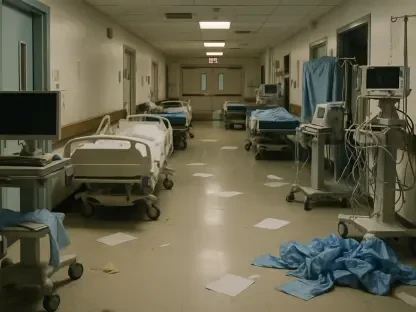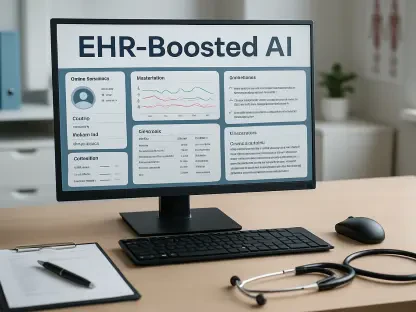Every September, Childhood Cancer Awareness Month brings into sharp focus the remarkable strides made in pediatric oncology, while also exposing the daunting challenges that continue to hinder progress. Over recent decades, survival rates for young patients have soared to an impressive 80-85%, a testament to relentless research and innovative, multidisciplinary care approaches. Yet, beneath this success lies a sobering truth: remission is often just the beginning of a lifelong struggle. Many survivors grapple with severe health issues stemming from aggressive treatments, while families endure profound emotional and financial strain. Access to specialized care remains uneven, leaving some children without critical support. Most alarmingly, recent cuts to research funding threaten to unravel decades of advancements, putting future breakthroughs at risk. This article explores the dual narrative of triumph and hardship in childhood cancer care, drawing on insights from leading experts like Dr. Debra Friedman of Vanderbilt and Dr. Peter Cole of Rutgers Cancer Institute to illuminate the complex barriers that persist in this vital field.
Progress and Challenges in Pediatric Oncology
Remarkable Advances in Survival Rates
The landscape of childhood cancer care has transformed dramatically over time, with survival rates now standing at an encouraging 80-85% for a five-year period following diagnosis, a remarkable achievement that stems from decades of rigorous scientific research and the development of comprehensive, multidisciplinary care models. Pediatric oncologists, alongside researchers and support staff, have worked tirelessly to turn once-fatal diagnoses into conditions that many children can now overcome. Collaborative efforts across medical institutions have played a pivotal role, ensuring that treatments are tailored to the unique needs of young patients. These advancements reflect a deep commitment to improving outcomes, providing hope to countless families facing the unimaginable. However, while the numbers paint a picture of progress, they do not capture the full scope of the journey that follows diagnosis and treatment, as many challenges remain unresolved for survivors and their loved ones.
Another layer of this success story lies in the innovative therapies and clinical trials that have redefined what is possible in pediatric oncology, transforming the landscape of treatment options for young patients. Targeted treatments and precision medicine have allowed for more effective interventions with potentially fewer side effects, though they are not yet universally accessible. The role of organizations advocating for childhood cancer research cannot be overstated, as their efforts have driven policy changes and funding allocations in the past. Survival statistics, while encouraging, vary across different cancer types, with some still carrying grim prognoses despite overall gains. This disparity underscores the need for continued focus on less understood or rarer forms of childhood cancer. As the medical community celebrates these milestones, there is a growing recognition that survival alone is not the ultimate goal—ensuring a high quality of life post-treatment is equally critical, a challenge that remains at the forefront of ongoing efforts.
Harsh Realities of Treatment Side Effects
Despite the impressive survival rates, the treatments that save young lives often come at a steep cost to long-term health, leaving many survivors with chronic conditions that can significantly impact their quality of life. Harsh therapies, including chemotherapy and radiation, can damage healthy tissues and organs, leading to issues such as heart disease, endocrine disorders, and compromised immune systems. Dr. Debra Friedman highlights that these treatments are rarely gentle, often causing irreversible harm that manifests years after remission. Survivors may face a lifetime of medical monitoring and interventions to manage these complications, a burden that can weigh heavily on both the individual and their family. The physical toll is undeniable, as children who beat cancer must often navigate a future marked by health challenges that their peers may never encounter, underscoring a critical gap in the current approach to pediatric cancer care.
Beyond physical damage, cognitive impairments represent another profound consequence of cancer treatments, significantly affecting survivors’ daily lives and posing challenges that can last a lifetime. Dr. Peter Cole points to “brain fog” and other cognitive difficulties as common side effects that can hinder academic performance and social integration. These challenges often persist into adulthood, impacting career prospects and personal development. Educational support systems, such as individualized learning plans, are sometimes necessary but not always available or adequate to address the unique needs of these survivors. The ripple effects extend to emotional well-being, as young individuals grapple with frustration and a sense of being different from their peers. Addressing these long-term side effects requires a shift in focus toward not just curing cancer but also minimizing the collateral damage of treatments, a priority that demands innovation and resources to improve the future for those who have already endured so much.
Psychosocial and Emotional Toll
Trauma and the Need for Support
A diagnosis of childhood cancer reverberates far beyond the physical, inflicting deep emotional and psychological wounds on both the patient and their family, often reshaping their entire worldview. The trauma of facing a life-threatening illness at a young age can lead to lasting mental health challenges, including anxiety, depression, and post-traumatic stress. Dr. Friedman describes this experience as profoundly disruptive, requiring families to forge a “new normal” in the aftermath of treatment. The impact varies widely, influenced by factors such as the child’s age at diagnosis, their pre-existing mental state, and the strength of their support network. Hospitals and care teams increasingly recognize the importance of integrating mental health services into treatment plans, yet resources for such support often remain limited. This gap highlights a critical need for broader access to counseling and trauma-informed care to help young patients and their loved ones navigate the emotional fallout of cancer.
Tailored psychosocial interventions are essential to address the diverse needs of childhood cancer patients and survivors, ensuring they are not left to cope alone with their experiences. Survivorship programs, which offer ongoing support post-treatment, are becoming a vital part of care at many medical centers, though their availability is far from universal. These programs may include peer support groups, therapy sessions, and guidance on reintegrating into school or social settings. Collaborations with educators and community resources can also play a significant role, helping to mitigate the isolation that often accompanies recovery. Dr. Cole emphasizes that personalized approaches are key, as no two children or families experience cancer in the same way. Expanding access to these supportive services remains a pressing concern, as emotional healing is just as crucial as physical recovery in restoring a sense of normalcy and hope for the future after such a harrowing journey.
Addressing Emotional Recovery Barriers
The emotional recovery process for childhood cancer survivors often encounters systemic obstacles that can exacerbate the trauma of their experience, leaving many families struggling to find the support they need. Access to mental health professionals trained in pediatric oncology issues is limited in many regions, leaving families without the specialized care necessary to process their ordeal. Insurance coverage for therapy or counseling services may be inadequate, forcing some to forgo essential support due to cost. Rural or underserved communities face additional hurdles, as mental health resources are often concentrated in urban academic centers far from home. This disparity can deepen feelings of isolation and hinder the ability to rebuild a sense of stability. Advocacy for policy changes to expand coverage and increase the availability of trained professionals is crucial to ensure that emotional recovery is not an afterthought but a core component of comprehensive cancer care.
Another challenge in emotional recovery lies in the societal stigma or misunderstanding surrounding childhood cancer, which can compound the psychological burden on survivors and their families, making the healing process even more difficult. Young patients returning to school or social environments may face insensitivity or exclusion, as peers and even educators struggle to comprehend the depth of their experience. Families, too, often grapple with well-meaning but unhelpful comments that minimize their ongoing struggles. Community education initiatives can help bridge this gap by fostering empathy and awareness about the lasting impact of cancer. Support networks, whether through local organizations or online platforms, offer a space for shared understanding, yet not all families are aware of or able to access these resources. Strengthening outreach efforts and creating inclusive environments where survivors feel understood can significantly aid in healing the invisible scars left by cancer, paving the way for true emotional resilience.
Financial and Access Inequities
Economic Strain on Families
The financial burden of childhood cancer care often extends far beyond medical bills, creating a relentless cycle of economic hardship for many families facing this devastating diagnosis, and the high cost of treatments, particularly for rare drugs produced in limited quantities, places an immense strain on household budgets. Beyond direct expenses, indirect costs such as travel to specialized treatment centers, accommodations, and time away from work add to the financial toll. Dr. Cole notes that parents frequently must reduce hours or leave jobs entirely to care for their child, risking loss of income and sometimes employer-provided insurance. This economic instability can persist long after treatment ends, as families work to recover from debt or depleted savings. The ripple effects touch every aspect of life, from housing security to the ability to afford basic necessities, underscoring a dire need for systemic solutions to alleviate these pressures.
Compounding the economic strain is the unpredictability of treatment timelines and outcomes, which makes financial planning nearly impossible for affected families. A single complication or relapse can escalate costs dramatically, pushing even middle-income households into crisis. Charitable programs and hospital-based financial assistance offer some relief, but they are not universally available and often come with complex eligibility criteria. Dr. Friedman points out that the rarity of childhood cancer means economies of scale rarely apply to drug production or care delivery, driving up expenses further. Advocacy for expanded insurance coverage and government subsidies could help offset these burdens, yet such measures remain inconsistent across states and regions. Until broader policy reforms address these disparities, many families will continue to face the agonizing choice between financial ruin and ensuring their child receives the best possible care, a dilemma no one should have to endure.
Gaps in Access to Specialized Care
Access to specialized childhood cancer care remains a significant barrier, with geographic and systemic inequities often determining the quality of treatment a child receives, and this disparity creates a critical challenge for many families across the country. Many cutting-edge therapies and clinical trials are concentrated in major academic medical centers, which are frequently located in urban areas far from rural or suburban communities. Families in remote regions may face long, costly journeys to access these facilities, a burden that can be insurmountable for those already stretched thin. Insurance status adds another layer of complexity, as coverage limitations or network restrictions can prevent children from receiving care at the most qualified centers. Dr. Friedman highlights that these access issues disproportionately affect lower-income families, who may lack the resources to navigate such obstacles, exposing a deep-rooted inequity in the healthcare system that demands urgent attention.
Particular demographics, such as adolescents and young adults, face unique challenges in accessing specialized care due to transitional gaps in the medical system. As patients age out of pediatric programs or parental insurance plans, they often fall into a coverage limbo, delaying or disrupting critical treatments. Dr. Cole emphasizes that this age group is less likely to be treated at academic centers due to logistical or financial barriers, which can result in poorer outcomes compared to younger children. Telemedicine offers a potential solution by connecting patients with distant specialists, but its adoption remains uneven, and not all insurers cover virtual consultations. Addressing these gaps requires a multifaceted approach, including policy changes to expand insurance access, increased funding for regional care centers, and innovative delivery models to bring expertise closer to home. Without such interventions, the promise of advanced care will remain out of reach for too many young patients in need.
Threats to Future Progress
Research Funding Cuts as a Critical Barrier
One of the most pressing threats to the future of childhood cancer care is the severe reduction in federal research funding, a cornerstone of the progress achieved over recent decades, and this issue is compounded by the fact that research has been the driving force behind every incremental improvement in survival rates and treatment efficacy. Yet, recent policy decisions have led to significant cuts in grants from institutions like the National Institutes of Health. These reductions have forced the cancellation of vital studies and layoffs of skilled researchers, stalling projects aimed at developing less toxic therapies and achieving higher cure rates. Dr. Friedman warns that the impact of these cuts is not just immediate but will reverberate for years, potentially reversing hard-won gains. With childhood cancer classified as a rare disease, the lack of commercial incentive for pharmaceutical companies to invest makes public and philanthropic funding indispensable, rendering these cuts a devastating blow to the field.
The consequences of diminished research funding extend beyond stalled innovation to the very pipeline of future pediatric oncologists and scientists dedicated to this cause, threatening the development of new treatments and the refinement of existing ones. Training programs and early-career grants, often the first casualties of budget reductions, are critical for cultivating the next generation of experts. Dr. Cole stresses that without sustained investment, the field risks losing talent to other specialties or industries, further eroding the capacity for breakthroughs. Current policies endanger not only the creation of new therapies but also improvements to current treatments aimed at reducing long-term side effects like organ damage or cognitive impairment. Advocacy efforts to restore funding levels are underway, but the urgency cannot be overstated—every delayed study represents a missed opportunity to save or improve a young life. Protecting research budgets must be a national priority to ensure that the momentum of past successes is not lost to short-sighted fiscal decisions.
Long-Term Risks of Stagnation
The long-term risks of research funding cuts are profound, threatening to halt progress toward the ultimate goal of a 100% cure rate for childhood cancer while improving survivors’ quality of life. Without consistent investment, the development of targeted therapies that minimize collateral damage to healthy tissues could grind to a halt, leaving future patients reliant on outdated, harsher treatments. The rarity of childhood cancer means that each research project, no matter how small, contributes to a critical body of knowledge that cannot be easily replicated or replaced. Dr. Friedman notes that past advancements were built on incremental discoveries, many of which took years to bear fruit—delays now could set the field back by decades. This stagnation would disproportionately impact children with less common or more aggressive cancers, for whom current options remain limited, deepening existing disparities in outcomes across cancer types.
Moreover, the ripple effects of research stagnation extend to global collaboration and data sharing, which are vital for tackling a disease as complex and varied as childhood cancer. International studies and shared clinical trials have historically accelerated progress by pooling resources and expertise, but funding shortages jeopardize these partnerships. Dr. Cole highlights that reduced budgets often force institutions to prioritize short-term projects over ambitious, long-range research that could yield transformative results. The loss of momentum also risks eroding public trust in medical science, as families and advocates see promised innovations fail to materialize. To counteract this, a renewed commitment to funding must be paired with strategic planning to allocate resources efficiently, ensuring that high-impact areas like survivorship care and rare cancer subtypes receive adequate attention. Without such foresight, the dream of a future free from the shadow of childhood cancer grows increasingly distant.
Reflecting on Past Efforts and Future Paths
Building on Historical Successes
Looking back, the fight against childhood cancer was marked by extraordinary dedication from researchers, clinicians, and advocates who refused to accept dismal prognoses as inevitable. Collaborative efforts transformed survival rates through persistent innovation, with multidisciplinary teams pioneering treatments that became global standards. Legislation in prior years often supported increased funding for pediatric research, reflecting bipartisan recognition of its importance. Stories of survivors who defied the odds inspired countless others, fueling philanthropy and grassroots movements that supplemented federal grants. Reflecting on these achievements, it became evident that progress was never accidental but the result of deliberate, sustained investment in science and care. Each milestone, from new drug approvals to advanced diagnostic tools, was a hard-fought victory that reshaped the landscape of pediatric oncology for generations.
Charting a Path Forward
Moving ahead, the lessons of history must guide actionable steps to overcome the barriers that still loom large in childhood cancer care, ensuring that every child has access to the best possible treatment and support. Restoring and safeguarding research funding stands as a non-negotiable priority, requiring advocacy to ensure policymakers understand the stakes. Expanding access to specialized care through regional hubs and telemedicine can bridge geographic gaps, while policy reforms to enhance insurance coverage could alleviate financial burdens. Survivorship programs deserve greater investment to address both physical and emotional long-term effects, ensuring no child or family is left to navigate recovery alone. Stakeholders, from government agencies to private donors, must unite in a shared commitment to innovation and equity. By prioritizing these strategies, the medical community can honor past triumphs while forging a future where every child facing cancer has not just a chance to survive, but to thrive without the shadow of lasting harm.









